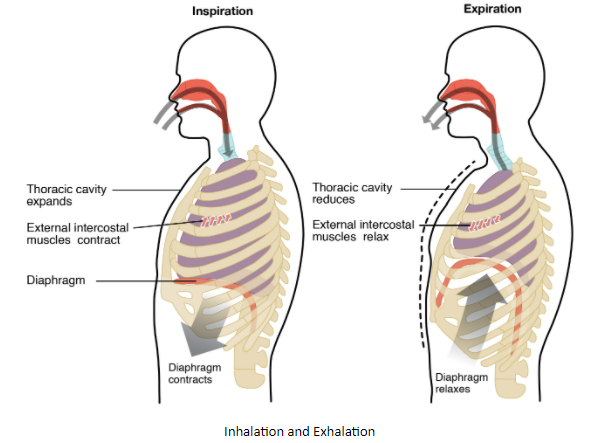
What Is the Inhalation Process?
Answer
512.1k+ views
Hint: The respiratory mechanism in people involves inspiration and expiration. Inspiration is the method in which the air is inhaled from outside to inside. It causes changes in the chest cavity and lungs. Inhalation is an important aspect of respiration.
Complete answer:
The essential organ of the respiratory system is the lungs. They help us to inhale the oxygen and exhale carbon dioxide. This is the procedure of exchange of gases and it is referred to as respiration. The human body does not require carbon dioxide, for this reason it is exhaled out. This is called exhalation.
Inhalation: During inhalation we inhale the oxygen. The first step obviously in the system of inhalation taking in the air which contains oxygen. Diaphragm is an organ that is present under the chest cavity and it contracts when the air is inhaled and relaxes when air is not being inhaled or at the time of exhalation.
Therefore, the 2nd step of inhalation is the contraction of diaphragm, and finally, the air pressure inside the lungs drops. Alveolar strain is the strain of the air inside the lung alveoli. So, all through inspiration, the improved volume of alveoli decreases the alveolar pressure.
The inhalation causes the diaphragm to contract as a result of which it moves downwards resulting in expansion of chest cavity. The flow of the air into the lungs helps in equalising pressure with the atmosphere.

Note: Human body requires oxygen for the processing of quite a number metabolic activity. The oxygenated blood is carried by way of arteries and deoxygenated blood is carried out with the aid of veins. Purification of blood takes the region in the lungs. Purified blood from the lungs is then despatched to the heart.
Complete answer:
The essential organ of the respiratory system is the lungs. They help us to inhale the oxygen and exhale carbon dioxide. This is the procedure of exchange of gases and it is referred to as respiration. The human body does not require carbon dioxide, for this reason it is exhaled out. This is called exhalation.
Inhalation: During inhalation we inhale the oxygen. The first step obviously in the system of inhalation taking in the air which contains oxygen. Diaphragm is an organ that is present under the chest cavity and it contracts when the air is inhaled and relaxes when air is not being inhaled or at the time of exhalation.
Therefore, the 2nd step of inhalation is the contraction of diaphragm, and finally, the air pressure inside the lungs drops. Alveolar strain is the strain of the air inside the lung alveoli. So, all through inspiration, the improved volume of alveoli decreases the alveolar pressure.
The inhalation causes the diaphragm to contract as a result of which it moves downwards resulting in expansion of chest cavity. The flow of the air into the lungs helps in equalising pressure with the atmosphere.

Note: Human body requires oxygen for the processing of quite a number metabolic activity. The oxygenated blood is carried by way of arteries and deoxygenated blood is carried out with the aid of veins. Purification of blood takes the region in the lungs. Purified blood from the lungs is then despatched to the heart.
Recently Updated Pages
Master Class 12 Business Studies: Engaging Questions & Answers for Success

Master Class 12 Economics: Engaging Questions & Answers for Success

Master Class 12 English: Engaging Questions & Answers for Success

Master Class 12 Maths: Engaging Questions & Answers for Success

Master Class 12 Social Science: Engaging Questions & Answers for Success

Master Class 12 Chemistry: Engaging Questions & Answers for Success

Trending doubts
What is meant by exothermic and endothermic reactions class 11 chemistry CBSE

Which animal has three hearts class 11 biology CBSE

10 examples of friction in our daily life

One Metric ton is equal to kg A 10000 B 1000 C 100 class 11 physics CBSE

1 Quintal is equal to a 110 kg b 10 kg c 100kg d 1000 class 11 physics CBSE

Difference Between Prokaryotic Cells and Eukaryotic Cells




